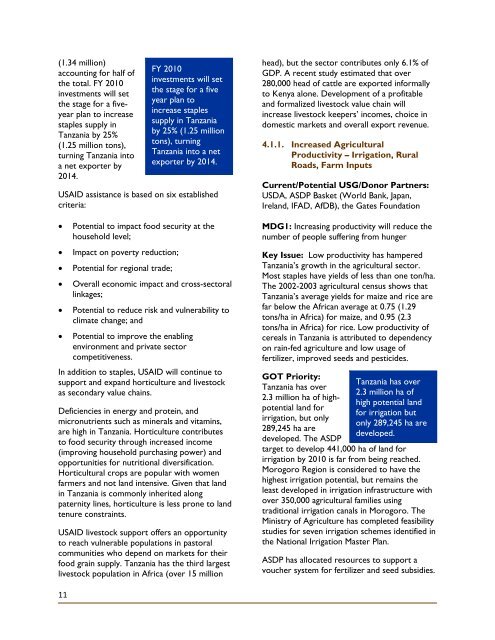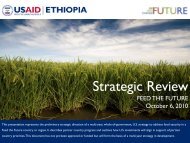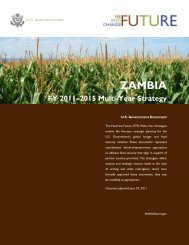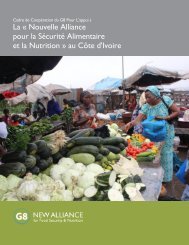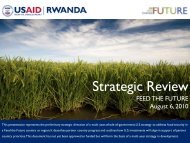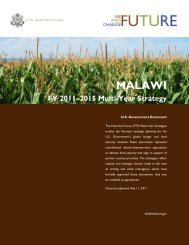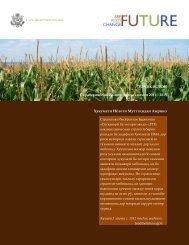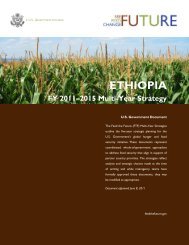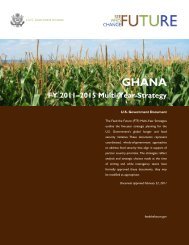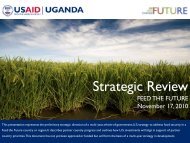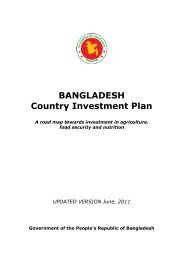Feed the Future FY 2010 Implementation Plan, Tanzania
Feed the Future FY 2010 Implementation Plan, Tanzania
Feed the Future FY 2010 Implementation Plan, Tanzania
- No tags were found...
You also want an ePaper? Increase the reach of your titles
YUMPU automatically turns print PDFs into web optimized ePapers that Google loves.
(1.34 million)accounting for half of<strong>the</strong> total. <strong>FY</strong> <strong>2010</strong>investments will set<strong>the</strong> stage for a fiveyearplan to increasestaples supply in<strong>Tanzania</strong> by 25%(1.25 million tons),turning <strong>Tanzania</strong> intoa net exporter by2014.USAID assistance is based on six establishedcriteria:Potential to impact food security at <strong>the</strong>household level;Impact on poverty reduction;Potential for regional trade;<strong>FY</strong> <strong>2010</strong>investments will set<strong>the</strong> stage for a fiveyear plan toincrease staplessupply in <strong>Tanzania</strong>by 25% (1.25 milliontons), turning<strong>Tanzania</strong> into a netexporter by 2014.Overall economic impact and cross-sectorallinkages;Potential to reduce risk and vulnerability toclimate change; andPotential to improve <strong>the</strong> enablingenvironment and private sectorcompetitiveness.In addition to staples, USAID will continue tosupport and expand horticulture and livestockas secondary value chains.Deficiencies in energy and protein, andmicronutrients such as minerals and vitamins,are high in <strong>Tanzania</strong>. Horticulture contributesto food security through increased income(improving household purchasing power) andopportunities for nutritional diversification.Horticultural crops are popular with womenfarmers and not land intensive. Given that landin <strong>Tanzania</strong> is commonly inherited alongpaternity lines, horticulture is less prone to landtenure constraints.USAID livestock support offers an opportunityto reach vulnerable populations in pastoralcommunities who depend on markets for <strong>the</strong>irfood grain supply. <strong>Tanzania</strong> has <strong>the</strong> third largestlivestock population in Africa (over 15 millionhead), but <strong>the</strong> sector contributes only 6.1% ofGDP. A recent study estimated that over280,000 head of cattle are exported informallyto Kenya alone. Development of a profitableand formalized livestock value chain willincrease livestock keepers’ incomes, choice indomestic markets and overall export revenue.4.1.1. Increased AgriculturalProductivity – Irrigation, RuralRoads, Farm InputsCurrent/Potential USG/Donor Partners:USDA, ASDP Basket (World Bank, Japan,Ireland, IFAD, AfDB), <strong>the</strong> Gates FoundationMDG1: Increasing productivity will reduce <strong>the</strong>number of people suffering from hungerKey Issue: Low productivity has hampered<strong>Tanzania</strong>’s growth in <strong>the</strong> agricultural sector.Most staples have yields of less than one ton/ha.The 2002-2003 agricultural census shows that<strong>Tanzania</strong>’s average yields for maize and rice arefar below <strong>the</strong> African average at 0.75 (1.29tons/ha in Africa) for maize, and 0.95 (2.3tons/ha in Africa) for rice. Low productivity ofcereals in <strong>Tanzania</strong> is attributed to dependencyon rain-fed agriculture and low usage offertilizer, improved seeds and pesticides.GOT Priority:<strong>Tanzania</strong> has over2.3 million ha of highpotentialland forirrigation, but only289,245 ha aredeveloped. The ASDP<strong>Tanzania</strong> has over2.3 million ha ofhigh potential landfor irrigation butonly 289,245 ha aredeveloped.target to develop 441,000 ha of land forirrigation by <strong>2010</strong> is far from being reached.Morogoro Region is considered to have <strong>the</strong>highest irrigation potential, but remains <strong>the</strong>least developed in irrigation infrastructure withover 350,000 agricultural families usingtraditional irrigation canals in Morogoro. TheMinistry of Agriculture has completed feasibilitystudies for seven irrigation schemes identified in<strong>the</strong> National Irrigation Master <strong>Plan</strong>.ASDP has allocated resources to support avoucher system for fertilizer and seed subsidies.11


